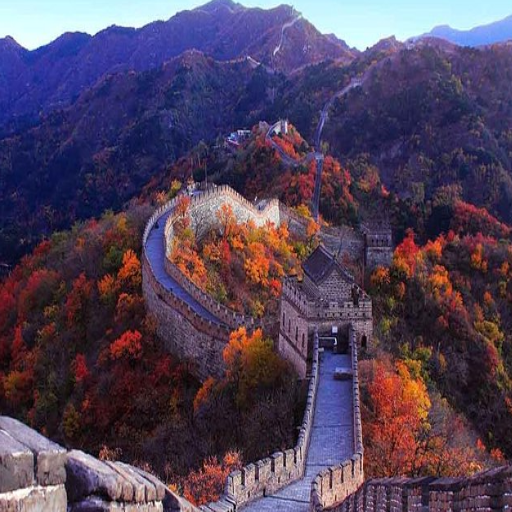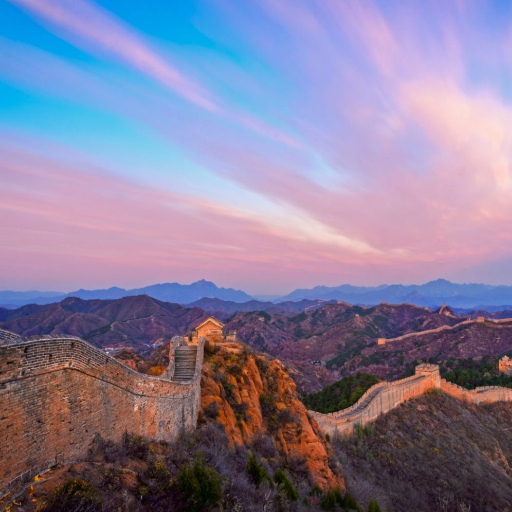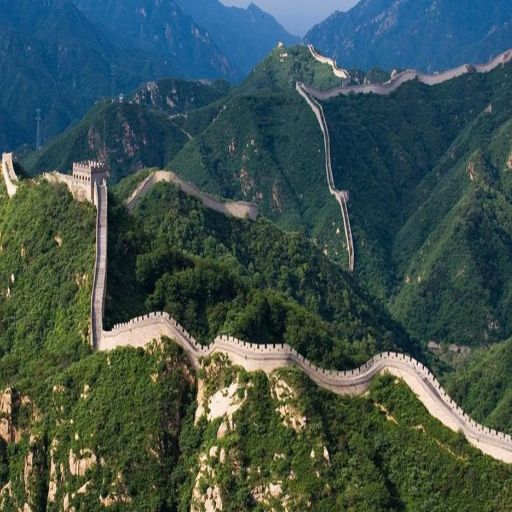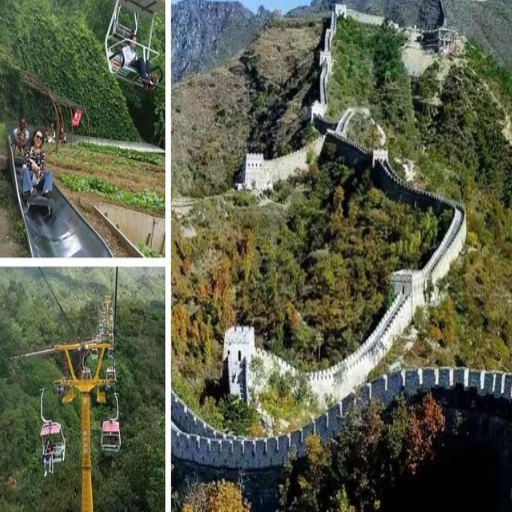The Great Wall of China—an ancient wonder and a remarkable feat of engineering—is among the most striking features in the world. This UNESCO World Heritage site offers insights into China's history and culture as it winds through steep valleys and mountainous terrain. Visiting in 2025 will allow you to appreciate this timeless masterpiece while enjoying modern traveler amenities. This blog post aims to equip you with the necessary information so that you can embark on an unforgettable adventure. It details the sections of the Wall, along with tips to cover its enormous scale, and shares the vibrant culture of Beijing. Let me take you along as we both unravel the wonders of the world’s architectural legend.
What to Expect on a Great Wall Tour?

Analysis of the Great Wall of China
The Great Wall of China is a structural wonder that spans approximately 13,000 miles (21,000 kilometers) across northern China. It is located in northern China and has been awarded a UNESCO World Heritage Site. With several sections built by the Qin, Han, and Ming dynasties, the wall was primarily constructed during the Ming dynasty to safeguard the Chinese states from invasions by nomadic groups and raids. Rather than a singular linear wall, this monumental structure is a belt of walls and fortifications, with telegraph towers serving the triple purpose of defense, communication, and transport.
Pieces of the wall were constructed from a range of local materials, including earth, wood, and partially burnt bricks. This section of the wall displays engineering genius coupled with adaptation to a great variety of different terrains, ranging from mountains to encroaching deserts to flat plains. Currently, the most famous and frequently visited section of the wall, which includes Badaling, Mutianyu, and Jinshanling, is a showcase of its augmented fame, drawing numerous tourists each year, and scaling the world’s love for Chinese history aside from the sheer wonder of the wall and its historical significance.
Aside from its celebrated historical value, the Great Wall is now renowned as a symbol of human resolve and achievement. Efforts undertaken nowadays focus on conserving the wall due to erosion caused by both nature and humans, thus ensuring that future generations will experience the glorious legacy of the wall in awe.
Different Kinds of Great Wall Tours
All tourists visiting the Great Wall of China can choose from a range of tour options that best suit their needs. If you're a more adventurous person, hiking tours give you the chance to walk along the wall, especially in the remote and less populated areas like Jiankou and Simatai. These areas have rugged landscapes, stunning views, and the raw nature near the wall's structure.
Casual travelers and families also have the option of guided day tours to Mutianyu and Badaling, which are best known for their preserved beauty. These sections are equipped with helpful amenities like cable cars, which make the areas more family-friendly. Mutianyu especially boasts lovely scenic views and a slightly less crowded atmosphere compared to other places.
Cultural tours that feature parts of the wall’s history and construction are popular among tourists with an intense interest in culture. Most of these guided tours have reliable storytellers who explain the wall's catalyzing history, its importance during the dynasty, and its modern-day conservation efforts. For photographers, having night tours in lit areas like Simatai gives them the perfect opportunity to photograph the wall at night.
Visitors who wish to participate in cycling, camping, or experience traditional Chinese culture can book customized tours. Such flexibility in design enables clients a deep level of personalization when navigating one of the most famous monuments in the world. Due to the abundance of options tailored to tourists' requirements, their trip to the Great Wall becomes historic and memorable.
How to Choose the Right Section of the Wall
With a length of over 13 thousand miles, the Great Wall is composed of many sections that vary in their distinct historical and architectural value. Some parts are completely restored and easy to access, while others are wild and rugged, retaining their untouched charm. The most popular section for tourists is Badaling, as it offers modern amenities and historical value. The friendly atmosphere of the Mutianyu section also makes it popular, mainly due to its dense forest, but it is often crowded with families seeking picturesque views and serenity.
The recommended sections for adventure lovers are Jinshanling and Simatai. These semi-restored stretches reveal the breathtaking beauty of the Great Wall and offer some of the best trekking in the world. Jiankou is known for its steep, wild, and rugged landscape, making it perfect for seasoned hikers seeking an unspoiled and challenging section of the wall. History lovers may prefer Gubeikou, which fortifies the wall's ancient military purpose with timeless hallmark features. The wall is further divided into sections to serve each traveler’s needs.
Which is the Best Section of the Great Wall to Visit?

Exploring Mutianyu: A Beautiful Great Wall Experience
Without a doubt, the Mutianyu section of the Great Wall of Ancient China is one of the most beautiful and well-preserved sections of the wall. This section is located 70 kilometers from Beijing, combining pristine nature with rich historical heritage. It was initially built in the sixth century and underwent considerable reconstruction during the Ming period, boasting reinforced watchtowers and over 3000 meters of defensive walls.
For travelers, the convenience offered by Mutianyu, including cable cars, toboggan rides, and various catering establishments, adds to its appeal as a travel hotspot. Those who do not want to undertake the steep hike can enjoy exquisite views of the forest mountains from a great height. The toboggan ride has become a favorite for travelers of different ages as it adds to their exhilarating downhill experiences. As you walk along the portion of the wall, you can find ornate battlements and detailed stone work, which provides evidence of the unmatched engineering skill of its designers.
Mutianyu, with its calm yet vivid landscapes, offers a range of vibrant, seasonally changing bushes, as well as loud summer greenery and milder autumn hues, catering to travelers of all ages. In addition to families, history lovers will also find great pleasure in visiting this architectural wonder.
What Makes Badaling Ideal for Your Tour?
Badaling is conveniently located within reach of major cities, only 43 miles from Beijing. Visitors can gaze upon remarkable natural scenery as they drive to Badaling, while also engaging in cultural exploration. When traveling to various surrounding regions, tourists are effortlessly welcomed within the region’s unmatched reserve. Most importantly, this section of the wall is the most stable and accessible. Badaling features extensive infrastructure, including a pedestrian walk, a visitor center, restrooms, walking tracks, and even cable cars. Dignitaries, including world leaders, were welcomed with open arms in this culturally rich yet well-preserved region.
Apart from providing universal accessibility and comfort, the rest of the mountains also offer vast panoramic views that perfectly showcase nature’s creations. Badaling has established a reputation globally, gaining recognition as a UNESCO World Heritage site. With such high regard, this region is recognized as one of the most iconic symbols of China’s unwavering resilience and rich history. Decorated with iconic symbols, Badaling skillfully provides unforgettable photo opportunities, making it the go-to spot for tourists. Still, this section holds an unrivaled travel history, gaining the title of one of the first walls to receive the green light for public tours in 1957. accessible section of Badaling enables tourists of any age and fitness level to relax and enjoy their trip without frustration. Even further, this opens countless opportunities for photo-worthy moments.
Comparing Mutianyu Great Wall and Badaling
Mutianyu and Badaling are two of the most well-known and well-preserved sections of the Great Wall of China, each with its unique characteristics and offerings. Compared to Badaling, Mutianyu is less crowded, making it a more popular tourist destination. It acts as a calming getaway for those seeking serenity, surrounded by lush forests. This section of the wall stretches for about 2.5 km and boasts 23 watchtowers, which allow its visitors to appreciate its architectural wonders and relative tranquility. Moreover, Mutianyu offers a cable car alongside a fun toboggan ride, making it an exciting option for adventurous tourists and families.
On the other hand, Badaling is famous for its historical importance as well as ease of access. It is the first section of the Great Wall to be opened to the public after lots of restoration work and serves as a monument to the glory of Chinese culture. Badaling’s walkways are wider, and the section is less strenuous compared to other areas of the Great Wall, making it easier for people of all ages and fitness levels to visit. This region is located closer to Beijing, which further adds to its popularity among tourists. Regardless, Badaling is famous for the bustling atmosphere during peak tourist seasons and can be less appealing to those who want a calm experience.
Both Mutianyu and Badaling have their benefits. If you seek unobstructed views and stunning nature, Mutianyu is for you. Otherwise, if unparalleled accessibility coupled with historically significant landmarks is what you’re looking for, Badaling stands out as the prime visit spot. Regardless, both sections of the wall showcase exceptional Chinese ingenuity while celebrating the country’s history.
How to Plan Your Day Trip from Beijing?

When It Comes to Timing, Visiting the Great Wall
The Great Wall is one of the world's wonders. The best time to visit it will depend on the seasons, because each season showcases a unique perspective of the wall. The Great Wall is beautiful in bloom during spring, and the view from it is breathtaking and unobstructed. Scrubs and clear views of The Wall, along with trekking up hills, need no background, making them even more appealing. Majestic Views in Autumn, lovely weather in Winter, and a Warm summer make everything better, further alleviating the experience.
Summer is particularly noteworthy because it becomes HOT! Summer doesn’t offer anything unique or special and tends to feel like the offseason. If you aren’t into bad weather, then opt for February, when the snow blanketing the wall transforms its appearance, and uncluttered pathways make for exploration. Since the temps are stable, there won’t be anything obstructing travel around the wall.
Drafting An Itinerary for Your Day Trip
An effective itinerary will enhance your experience when visiting the Great Wall of China. To better enjoy the Great Wall of China, wake up early so you can experience its beauty without the rush of many visitors. An access point to the Great Wall of China is Mutianyu. It is less crowded than Badaling. Mutianyu is equipped with a cable car system, making it effortless to view the landscapes. With this equipment, you can spend more time sightseeing.
Savor the views and photos for at least two to three hours. Take a walk along the flat and steep grounds of the Great Wall. Wear open-toed shoes to facilitate movement, as the area's landscape has an increased elevation. While traveling, picture and caption. Enjoy the stunning vistas. For lunch, authentic cuisine at nearby stores would be a great choice. You can also pack a meal and consume it at designated picnic areas.
Your pace and interests determine how many cultural attractions you can visit during your afternoon plans. You could check out local shops that sell traditional crafts and souvenirs, or you can go to small museums that showcase the history of the Wall. Relish the exhilarating experience while leaving time for a rest. A meticulously crafted itinerary can help you achieve the desired balance of adventure, history, and convenience during your visit.
Tips for Booking Great Wall of China Tours tickets
When approached with the right strategies, booking tickets for the Great Wall can be a simple process. For instance, during peak tourist seasons, you can consider buying them from an official or trusted site well in advance to avoid waiting times. Some ticketing websites even offer packages that include guided tours, transport, and tickets to other attractions, such as cable cars and toboggan rides.
When visiting the Great Wall of China, take note of the specific section you want to see, as ticket prices and policies vary by attraction site. Sections of the Wall, such as Badaling and Mutianyu, offer comprehensive facilities. In contrast, the less crowded Jinshanling section provides a more tranquil experience, albeit a slightly rugged one. Be aware of the operating hours, as some parts of the Wall may have restricted seasonal access or entry delays.
In addition, check if there are any available discounts for students, seniors, or large groups, as these can significantly reduce expenses. Make sure to check the cancellation policy, as it should offer flexibility if the plan requires changes. Staying informed enables Chinese wall tours to be hassle-free.
What are the Options for Private Tours?

Advantages of a Private Tour to the Great Wall
To visit the Great Wall, a private tour provides unmatched suitability, ease of travel, and unique customization tailored to individual needs. Unique Private tours focus on specific sections of the Wall, so tourists can appreciate the stunning scenery and its important historical value without being rushed. Tour guides who accompany private tourists usually have a passion for China's history and culture and provide engaging narratives about the wall, its construction, and nearby landmarks.
One more important advantage is private tours. Unlike public group tours, which have crowds that tourists have to maneuver through, private tours offer greater peace and reduced tumult. Private travelers are also given the chance to change parts of their travel lists, such as the Ming Tombs, other local villages, and merge them with the Great Wall visit for better cultural appreciation. Also, a private tour often comes with provided transport, which makes travel from the accommodation to the selected section of the Wall easier. Exclusivity enhances comfort and shared enjoyment for families or groups, enabling them to create lasting, unforgettable memories together.
How to Make the Most of Your Private Tour
To make the most out of your private tour of the Great Wall of China, consider paths that are of cultural significance. Consider including private, air-conditioned vehicles that alleviate travel aggravations. In addition to the chosen guide being a fluent English speaker, consider packing breathable clothing and sturdy hiking shoes, as well as sunscreen and insect repellent.
For a luxurious feel, tourists are often treated to catered meals served at scenic dining spots that overlook the Wall. Structures that allow tourists to reminisce about the delicious dishes after retiring from their adventure, taking in the scenery, and gaining authentic historical knowledge, provide a sense of remembrance. Alongside serving delicious meals, engaging tourists with captivating local history will transform their retelling of tales after a recount into real fairy tales filled with adventure, marveling at the wonders of the ancient world.
Lastly, stops at artisan workshops nearby deepen tourists' connection with the country’s roots and allow a taste of the local craftsmanship prowess. These tips ensure pleasant, tailored experiences and lasting memories at the signature site of a World Heritage, architectural marvel, The Great Wall of China.
How to Customize Your Great Wall Tour
With customization, you can create an experience that truly stands out when touring the Great Wall of China. First, pick the part of the wall that best caters to your preference. The well-preserved Mutianyu section is great for families, as it is easy to navigate, thanks to cable cars. If you prefer fewer crowds, the Simatai section is less populated and is famous for its stunning architecture. If you are an adventurer, the Jiankou wild section offers spectacular views and a sense of solitude.
Also, consider the time of visit to avoid human traffic to ensure maximum enjoyment. Sunrise tours offer a calm setting with surreal lighting for photos, while evening visits to illuminated parts like Simatai are enchanting. Some tour operators offer exclusive experiences along with private evening access, making it even better.
Make sure you do not disregard employing a qualified local guide for context and compelling hidden details about the Wall's construction. Many guides are specially tailored to specific interests.
Ultimately, investigate packages that offer private car services or curated add-ons such as regional food picnics and calligraphy classes in nearby villages. With the proper planning and companions, your Great Wall tour can be customized into a memory that lasts a lifetime.
What Activities Can You Enjoy at the Great Wall?

Wall Hiking: An Adventurous Experience
Hiking the Great Wall is one of the most incredible experiences I've had in my lifetime. As I set foot on the wall, the towering mountains, fertile valleys, and exquisitely crafted stonework captured my attention. It was mesmerizing to observe how all these structures had withstood the passage of time. Each step along the wall reveals its distinct character. History intertwined with nature left every part of the wall feeling like a world untouchable by modern civilization. The balance of history, nature, and adventure made the hike into a profoundly self-journeying experience.
But the most breathtaking moment came when I was physically and mentally taxed to my limits. Some parts of the Great Wall, rather like Jinshanling or Simatai, present quite steep and rugged challenges which test my hiking abilities, but at the same time reward me with panoramic views like never before. Throughout the hike, the wall's massive scale and the encouragement it offered me helped maintain my energy levels. In every section that I completed, the calm atmosphere paired with the overwhelming sense of achievement made the harsh trek worth it.
My appreciation for the Great Wall's historical significance and the beauty of the surrounding nature deepened while hiking it. Whether conquering the “wild wall,” which is still in its natural state, or walking on the popular smoother paths, the journey provided a timeless experience. This wonder of the world can be vigorously and actively engaged with. As such, I would recommend this to anyone looking for a meaningful and intriguing adventure.
Cable Car Ride Offers an Experience with Great Views
Riding in the cable car to see the Great Wall of China feels like an adventure that should be celebrated. The breathtaking scenery and sense of adventure made it unforgettable. The cable car moves smoothly, floating above the landscape and providing a panoramic view of the awe-inspiring mountains, along with parts of the Wall. It offered an unparalleled view of the region's magnificence, as well as the scale of the wall, which cannot be appreciated from ground level. Additionally, realizing how the Wall was constructed made the Wall, located higher than us, seem astonishing.
Of course, the lift served as an effective means of reaching the upper or more distant areas of the Wall. At the same time, the ride felt like an adventure. The peaceful buzz of the lift, mixed with some of the natural sounds, was calm, yet uplifting. This is the best method for those who lack adequate time or have limited mobility, as the cable car allows you to retain the views. Moreover, it helped me conserve the energy required to explore the Wall after I reached the base.
In my opinion, the lift was an essential part of my journey, as it served me well throughout the trip and also gave me relief from travel fatigue. If I could, I would recommend that everyone near the Great Wall of China take a short trip on the lift as well, whether they want to explore the mountain or have a hilltop experience. The ride remarkably enhanced what is already a breathtaking place, adding even additional layers of intrigue.
Tobogganing: A Fun Activity at Mutianyu
Without a doubt, one of the most exciting and fun parts of my Trip to the Great Wall was the toboggan ride at Mutianyu. After I had finished soaking up the incredible sights and the magnificent pieces of history that lay in front of me, the toboggan offered another option for going down…it was not only fun, but also quite different! Unlike the steady, slow-moving cable car, the toboggan ride provided excitement in the form of speed control; it features a metal track with many curves. The wind rushing around mingled beautifully with the green landscape around the track, making it feel downright amazing.
What I liked the best about the toboggan was how simple it was to operate. The straightforward handle controls let me manage the speed to my liking, which is perfect for anyone who might be a bit anxious. For people like me who want some thrills, speeding up a little bit added an extra layer of exhilaration. The balance of fun and safety was remarkable, and makes it suitable for people of all ages. The track slopes gently down the hillside, which helps provide beautiful views along the way. So even if you decide to go slow, it’s still a remarkable ride.
Thinking back on my day, I noticed how much the toboggan contributed to my experience at Mutianyu. It was not just a means of locomotion; it was an experience in its own right. The ride served as an addition to the playful side of the otherwise historical and cultural exploration of the wall, enhancing the experience significantly. If you're visiting Mutianyu, I strongly suggest trying the toboggan ride - you won't regret it.
Frequently Asked Questions (FAQs)
Q: What does a typical visit to the Great Wall encompass?
A typical visit to the Great Wall includes transportation from Beijing to the selected section of the wall, a local guide, and sometimes, the entrance fees required to enter the wall. In addition, some tours may provide meals as well as opportunities to visit nearby attractions like the Forbidden City and the Summer Palace.
Q: Do the Great Wall tours offer cancellation policies?
A: Yes, almost all tour operators have a cancellation policy. Many of them allow for free cancellation, as long as you cancel within a specific timeframe before the tour date. Check with the provider you choose to confirm.
Q: For first-time visitors, which sections of the Great Wall would you recommend?
A: To first time visitors, I would advise the Badaling Great Wall as it is famous for being well-maintained, and Mutianyu is also loved for its stunning views, making it a popular choice for day-tours from Beijing.
Q: Do you have to join a group to visit the Great Wall?
A: You do not have to join a group to visit the Great Wall, especially if you have a private driver at your disposal. If you do join a guided tour, however, you will benefit from hearing history and highlights of significant points of interest along the wall.
Q: What best suits the dress code for a tour of the Great Wall?
A: Please wear appropriate and comfortable walking shoes, as you will have to walk and hike parts of the wall, such as Jinshanling or the wild Great Wall, which are steep and rugged. In addition, wear clothes that are easy to remove, in case the weather changes.
Q: Does the Great Wall have tours suitable for families with children?
A: Absolutely, all family members can enjoy Great Wall tours offered by countless operators, many of which include child-friendly shorter hikes and crafts aimed at a younger audience. Some of those excursions may also encompass other sites near Beijing.
Q: What is the recommended means of travel from Beijing to the Great Wall?
A: If you're traveling to the Great Wall from Beijing, your options include public transportation, private chauffeured services, and guided tours. Many Beijing day tours include transportation, departing at set times and taking other travelers to popular places like Badaling or Mutianyu.
Q: What other locations combined with the Great Wall do you recommend visiting?
A: Spring (April to June) and autumn (September to November) are recommended, as these months tend to have milder temperatures and beautiful scenery. Avoid visiting during summer peak or major holidays, otherwise your experience will not be enjoyable.
Q: Can I visit the unrestored parts of the Great Wall?
A: Indeed, the Great Wall’s wild regions are mostly wild, and their exploration can be adventurous. These parts of the wall give you a true feeling of nature, though tackling them requires more effort. Therefore, it’s better to have a local guide when visiting these places.


